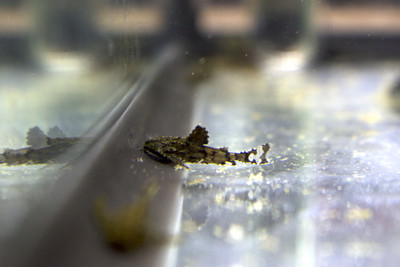Banjo Catfish
Posted by Max Gandara on on 18th Jun 2025
Banjo Catfish: The Master of Disguise in the Aquarium
Bunocephalus spp.
If you’re looking for a fish that combines stealth, personality, and low-maintenance care, look no further than the Banjo Catfish. Named for its flattened, banjo-shaped body and cryptic appearance, this fascinating bottom-dweller is a true hidden gem in the freshwater aquarium world.
An Aquatic Oddball Worth Discovering
Banjo Catfish belong to the Bunocephalus genus and are native to the slow-moving, silty waters of South America, particularly the Amazon and Orinoco river basins. With their camouflaged, leaf-like coloration, they blend perfectly into soft substrates and detritus, often going completely unnoticed even in smaller tanks.
These fish have a truly prehistoric look and are built for a life of stillness and stealth—until food hits the water.
Behavior & Personality
The Banjo Catfish is a nocturnal and incredibly shy species, spending most of the day buried under sand or resting motionless along the bottom. At night, they become more active, foraging for food with slow, deliberate movements.
Though secretive, Banjo Catfish have a laid-back personality and won’t bother tank mates. They rarely swim in open water and prefer to stay hidden, making them ideal for aquarists who enjoy spotting elusive species.
Aquarium Requirements
Banjo Catfish thrive in tanks that mimic their natural habitat—soft, silty bottoms, low lighting, and lots of cover.
Ideal Tank Setup:
-
Tank Size: 20 gallons or more
-
Temperature: 72–79°F (22–26°C)
-
pH: 6.0–7.5
-
Substrate: Sand or fine gravel (a must for burrowing)
-
Décor: Leaf litter, driftwood, caves, and dim lighting
-
Filtration: Gentle flow preferred—these fish come from calm waters
They are sensitive to poor water quality, so regular maintenance and stable conditions are important.
Diet & Feeding
Banjo Catfish are omnivorous scavengers. In the wild, they feed on insect larvae, worms, and decaying plant matter. In captivity, they readily accept a variety of sinking foods.
Best food options include:
-
Sinking carnivore pellets or wafers
-
Frozen or live bloodworms, brine shrimp, or blackworms
-
Occasional vegetable matter or algae wafers
-
Uneaten food that falls to the bottom—just don't overfeed
Feed them after lights out to match their nocturnal nature and ensure they get their share before daytime fish clean up.
Tank Mates
Banjo Catfish are peaceful and reclusive, making them suitable for calm community tanks with:
-
Tetras and rasboras
-
Peaceful dwarf cichlids
-
Corydoras
-
Small loaches
-
Snails and shrimp (though very small shrimp may be eaten)
Avoid housing them with large, aggressive fish that may outcompete them for food or disturb their substrate.
Breeding
Breeding Banjo Catfish in captivity is rare but possible. Spawning typically requires soft, acidic water and seasonal changes in temperature and water levels to simulate rainy season cues. Eggs are usually laid under cover and guarded until they hatch.
Final Thoughts
The Banjo Catfish is a quirky, peaceful bottom-dweller that brings subtle charm and fascinating behavior to the aquarium. While not a showy centerpiece fish, it’s perfect for aquarists who enjoy natural setups and observing hidden, nocturnal species. Give them the right environment, and they’ll reward you with years of quiet, low-key companionship.
Add a Banjo Catfish to your aquarium and enjoy one of nature’s most effective masters of disguise—available now at Petzonesd.com!

